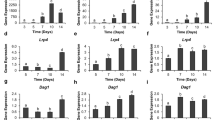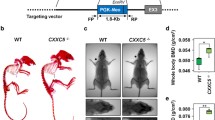Abstract
In the past years, WNT16 became an interesting target in the field of skeletal research, as it was identified as an essential regulator of the cortical bone compartment, with the ability to increase both cortical and trabecular bone mass and strength in vivo. Even though there are indications that these advantageous effects are coming from canonical and non-canonical WNT-signalling activity, a clear model of WNT signalling by WNT16 is not yet depicted. We, therefore, investigated the modulation of canonical (WNT/β-catenin) and non-canonical [WNT/calcium, WNT/planar cell polarity (PCP)] signalling in human embryonic kidney (HEK) 293 T and SaOS2 cells. Here, we demonstrated that WNT16 activates all WNT-signalling pathways in osteoblasts, whereas only WNT/calcium signalling was activated in HEK293T cells. In osteoblasts, we therefore, additionally investigated the role of Gα subunits as intracellular partners in WNT16′s mechanism of action by performing knockdown of Gα12, Gα13 and Gαq. These studies point out that the above-mentioned Gα subunits might be involved in the WNT/β-catenin and WNT/calcium-signalling activity by WNT16 in osteoblasts, and for Gα12 in its WNT/PCP-signalling activity, illustrating a novel possible mechanism of interplay between the different WNT-signalling pathways in osteoblasts. Additional studies are needed to demonstrate whether this mechanism is specific for WNT16 signalling or relevant for all other WNT ligands as well. Altogether, we further defined WNT16′s mechanism of action in osteoblasts that might underlie the well-known beneficial effects of WNT16 on skeletal homeostasis. These findings on WNT16 and the activity of specific Gα subunits in osteoblasts could definitely contribute to the development of novel therapeutic approaches for fragility fractures in the future.




Similar content being viewed by others
References
Boudin E et al (2013) The role of extracellular modulators of canonical Wnt signaling in bone metabolism and diseases. Semin Arthritis Rheum 43(2):220–240
Dann CE et al (2001) Insights into Wnt binding and signalling from the structures of two Frizzled cysteine-rich domains. Nature 412(6842):86–90
Dijksterhuis JP, Petersen J, Schulte G (2014) WNT/Frizzled signalling: receptor-ligand selectivity with focus on FZD-G protein signalling and its physiological relevance: IUPHAR Review 3. Br J Pharmacol 171(5):1195–1209
Boudin E et al (2016) Genetic control of bone mass. Mol Cell Endocrinol 432:3–13
Estrada K et al (2012) Genome-wide meta-analysis identifies 56 bone mineral density loci and reveals 14 loci associated with risk of fracture. Nat Genet 44(5):491–501
Kemp JP et al (2016) Genome-wide association study of bone mineral density in the UK Biobank Study identifies over 376 loci associated with osteoporosis. In: American Society of Bone and Mineral Research, annual meeting 2016 abstracts
Hendrickx G, Boudin E, Van Hul W (2015) A look behind the scenes: the risk and pathogenesis of primary osteoporosis. Nat Rev Rheumatol 11(8):462–474
Chesi A et al (2015) A trans-ethnic genome-wide association study identifies gender-specific loci influencing pediatric aBMD and BMC at the distal radius. Hum Mol Genet 24(17):5053–5059
Garcia-Ibarbia C et al (2013) Missense polymorphisms of the WNT16 gene are associated with bone mass, hip geometry and fractures. Osteoporos Int 24(9):2449–2454
Hendrickx G et al (2014) Variation in the Kozak sequence of WNT16 results in an increased translation and is associated with osteoporosis related parameters. Bone 59:57–65
Koller DL et al (2013) Meta-analysis of genome-wide studies identifies WNT16 and ESR1 SNPs associated with bone mineral density in premenopausal women. J Bone Miner Res 28(3):547–558
Medina-Gomez C et al (2012) Meta-analysis of genome-wide scans for total body BMD in children and adults reveals allelic heterogeneity and age-specific effects at the WNT16 locus. PLoS Genet 8(7):e1002718
Moayyeri A et al (2014) Genetic determinants of heel bone properties: genome-wide association meta-analysis and replication in the GEFOS/GENOMOS consortium. Hum Mol Genet 23(11):3054–3068
Zhang L et al (2014) Multistage genome-wide association meta-analyses identified two new loci for bone mineral density. Hum Mol Genet 23(7):1923–1933
Zheng HF et al (2012) WNT16 influences bone mineral density, cortical bone thickness, bone strength, and osteoporotic fracture risk. PLoS Genet 8(7):e1002745
Moverare-Skrtic S et al (2014) Osteoblast-derived WNT16 represses osteoclastogenesis and prevents cortical bone fragility fractures. Nat Med 20(11):1279–1288
Alam I et al (2017) Bone mass and strength are significantly improved in mice overexpressing human WNT16 in osteocytes. Calcif Tissue Int 100(4):361–373
Alam I et al (2016) Osteoblast-specific overexpression of human WNT16 increases both cortical and trabecular bone mass and structure in mice. Endocrinology 157(2):722–736
Moverare-Skrtic S et al (2015) The bone-sparing effects of estrogen and WNT16 are independent of each other. Proc Natl Acad Sci USA 112(48):14972–14977
Gori F et al (2015) A new WNT on the bone: WNT16, cortical bone thickness, porosity and fractures. Bonekey Rep 4:669
Jiang Z et al (2014) Wnt16 is involved in intramembranous ossification and suppresses osteoblast differentiation through the Wnt/beta-catenin pathway. J Cell Physiol 229(3):384–392
Dorsam RT, Gutkind JS (2007) G-protein-coupled receptors and cancer. Nat Rev Cancer 7(2):79–94
Worzfeld T, Wettschureck N, Offermanns S (2008) G(12)/G(13)-mediated signalling in mammalian physiology and disease. Trends Pharmacol Sci 29(11):582–589
McQuillan DJ, Richardson MD, Bateman JF (1995) Matrix deposition by a calcifying human osteogenic sarcoma cell line (SAOS-2). Bone 16(4):415–426
Murray E et al (1987) Characterization of a human osteoblastic osteosarcoma cell line (SAOS-2) with high bone alkaline phosphatase activity. J Bone Miner Res 2(3):231–238
Rodan SB et al (1987) Characterization of a human osteosarcoma cell line (Saos-2) with osteoblastic properties. Cancer Res 47(18):4961–4966
Schulte G, Bryja V (2007) The Frizzled family of unconventional G-protein-coupled receptors. Trends Pharmacol Sci 28(10):518–525
Riobo NA, Manning DR (2005) Receptors coupled to heterotrimeric G proteins of the G12 family. Trends Pharmacol Sci 26(3):146–154
Fujino H, Regan JW (2001) FP prostanoid receptor activation of a T-cell factor/beta-catenin signaling pathway. J Biol Chem 276(16):12489–12492
Meigs TE et al (2002) Galpha12 and Galpha13 negatively regulate the adhesive functions of cadherin. J Biol Chem 277(27):24594–24600
Meigs TE et al (2001) Interaction of Galpha 12 and Galpha 13 with the cytoplasmic domain of cadherin provides a mechanism for beta-catenin release. Proc Natl Acad Sci USA 98(2):519–524
Nygren MK et al (2009) beta-catenin is involved in N-cadherin-dependent adhesion, but not in canonical Wnt signaling in E2A-PBX1-positive B acute lymphoblastic leukemia cells. Exp Hematol 37(2):225–233
Yang L et al (2007) Rho GTPase Cdc42 coordinates hematopoietic stem cell quiescence and niche interaction in the bone marrow. Proc Natl Acad Sci USA 104(12):5091–5096
Du C, Xie X (2012) G protein-coupled receptors as therapeutic targets for multiple sclerosis. Cell Res 22(7):1108–1128
Guerram M, Zhang LY, Jiang ZZ (2016) G-protein coupled receptors as therapeutic targets for neurodegenerative and cerebrovascular diseases. Neurochem Int 101:1–14
Lappano R, Maggiolini M (2011) G protein-coupled receptors: novel targets for drug discovery in cancer. Nat Rev Drug Discov 10(1):47–60
Reimann F, Gribble FM (2016) G protein-coupled receptors as new therapeutic targets for type 2 diabetes. Diabetologia 59(2):229–233
Acknowledgements
This work was supported by the Systems Biology for the Functional Validation of Genetic Determinants of Skeletal Diseases (SYBIL, Project ID 602300) Project funded by the European Commission. G.H. holds a Rosa Blanckaert Legacy Grant for Young Investigators from the University of Antwerp (Project ID 32435; www.uantwerpen.be). E.B. holds a Post-doctoral Fellowship of the FWO Flanders (FWO Personal Grant 12A3814N). M.V. is supported by Donations from the “Siebe Van Reusel Fonds”.
Author information
Authors and Affiliations
Contributions
Study design: GH, EB and WVH. Study conduct: GH. Data analysis: GH, EB, MV and EF. Data interpretation: all authors. Drafting manuscript: GH and MV. Revising manuscript: all authors. Approving manuscript for publication: all authors. GH takes responsibility for the integrity of the data analysis.
Corresponding author
Ethics declarations
Conflict of interest
Gretl Hendrickx, Eveline Boudin, Marinus Verbeek, Erik Fransen, Geert Mortier and Wim Van Hul declare that they have no conflict of interest.
Human and Animal Rights and Informed Consent
This article does not contain any studies with human or animal subjects performed by any of the authors.
Additional information
Publisher's Note
Springer Nature remains neutral with regard to jurisdictional claims in published maps and institutional affiliations.
Electronic supplementary material
Below is the link to the electronic supplementary material.
Rights and permissions
About this article
Cite this article
Hendrickx, G., Boudin, E., Verbeek, M. et al. WNT16 Requires Gα Subunits as Intracellular Partners for Both Its Canonical and Non-Canonical WNT Signalling Activity in Osteoblasts. Calcif Tissue Int 106, 294–302 (2020). https://doi.org/10.1007/s00223-019-00633-x
Received:
Accepted:
Published:
Issue Date:
DOI: https://doi.org/10.1007/s00223-019-00633-x




